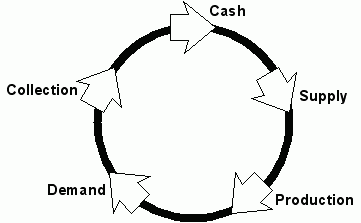Business risk: Assessment of the companyґs strengths and weaknesses
Category: Corporate Banking
Next, a credit analyst has to identify and give priority to the particular strengths and weaknesses of a corporate client and compare them with those of other players in the same industry. What we need to find out is how the company responds to the threats and opportunities of its industry. Knowledge of the companies capabilities and of the causes of competitive forces will highlight the areas where
— a company should confront competition and where it should avoid it,
— the firm should invest and where further investments should be considered with great caution, if at all.
This coupling of realistic knowledge of corporate strengths with sound industry analysis will provide the bank with a first impression of the risks associated with a specific company.
1. The business cycle
A tool that is helpful to assess the strengths and weaknesses in a systematic manner is the business cycle. The operations of a company can be understood as a cycle. Every company invests cash to buy raw materials. It adds value in the manufacturing process to convert raw materials into finished goods. The finished goods are sold, often on credit terms. In order to generate new cash, the company must ensure that its customers finally pay their bills. Thus, the business cycle can be represented as follows:
The Business Cycle
The single stages of the business cycle have to be discussed, in what respects they represent a strength or a weakness of the company. It is important to know the related data for the entire industry, such as market volume, demand dynamics or key ratios for cost structure, productivity, equity ratios and so on.
a. Production: Productivity can be measured, for example, by comparing total output per employee with similar companies. Industry specific ratios can be, for example, the use and quality of selling space in the retailing industry; sales per square meter should be a good indicator. Commercial airlines measure their productivity by comparing the ratio of passengers to seats on a given flight. As soon as enough seats have been sold to passengers to cover the very high fixed costs of airlines, every additional seat sold is pure profit. The same is true for the occupancy rates of hotels. So every sector has its own particular ratios, which a credit analyst should know in order to assess his corporate clients position in its industry.
b. Supply: Balance sheet figures like short-term trade payables or the credit taken by suppliers can give hints as to whether a company is dependent on one single major supplier.
c. Collection: Short-term receivables and the credit taken by customers (complete with aging schedule), on the other hand, may serve as indicators for a company’s ability to collect cash.
d. Demand: A client should also be asked to give a breakdown of his sales by major customers, divisions and geographic regions.
It is important that a credit analyst builds an anticipation of what ought to be expected in a specific industry, and how this should be reflected in a companies balance sheet. Only a thorough understanding of a corporate clients business and its industry can enable him to ask the right question and to correctly assess the risks connected with lending to a firm.
e. Worksheet: SWOT-Analysis
SWOT-Analysis
Business Risk Analysis of a Company

